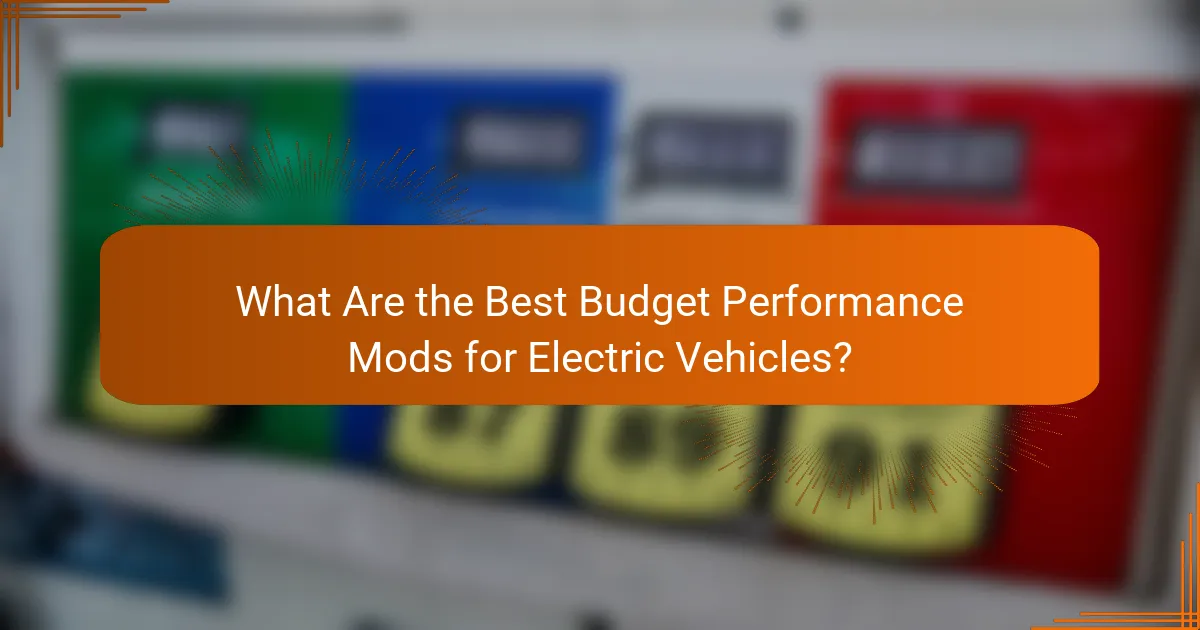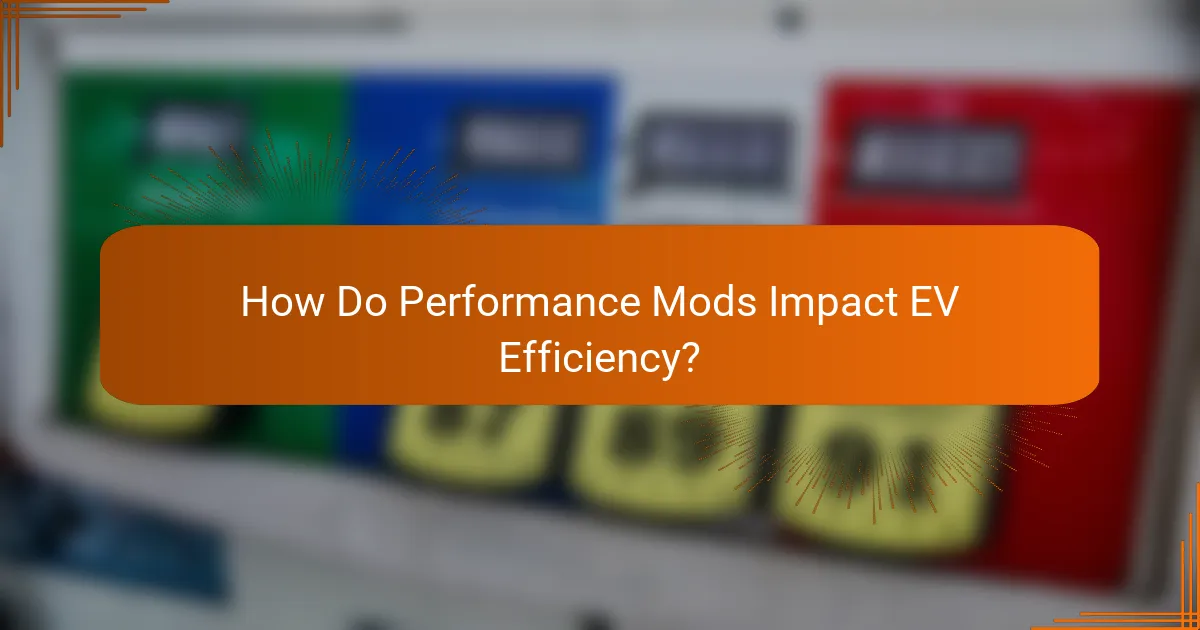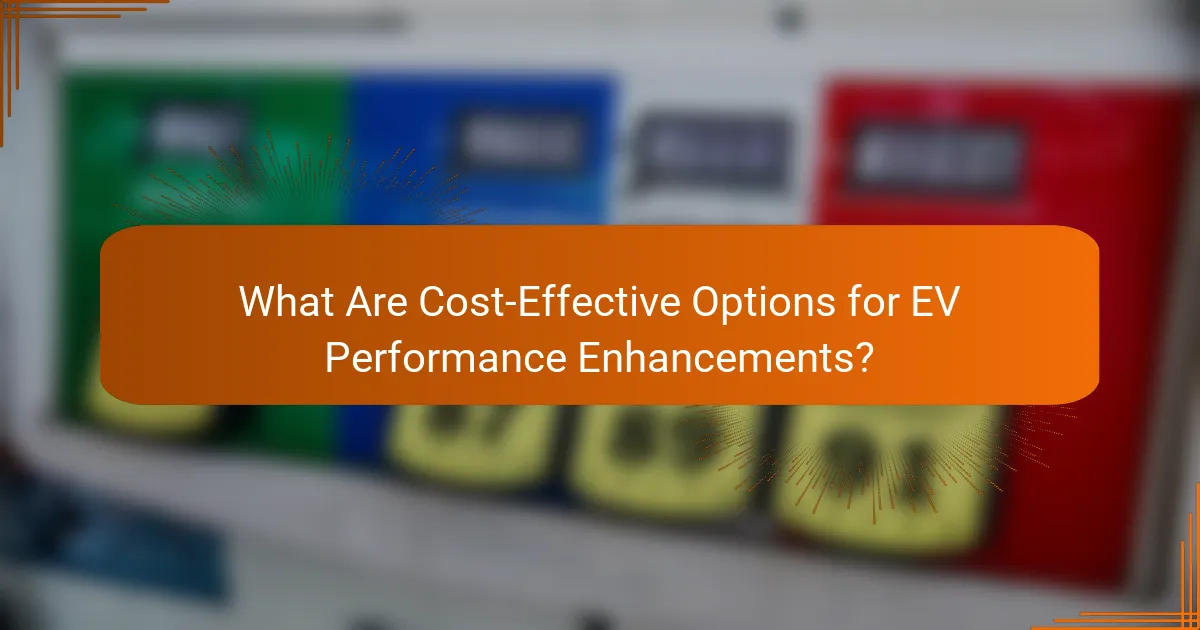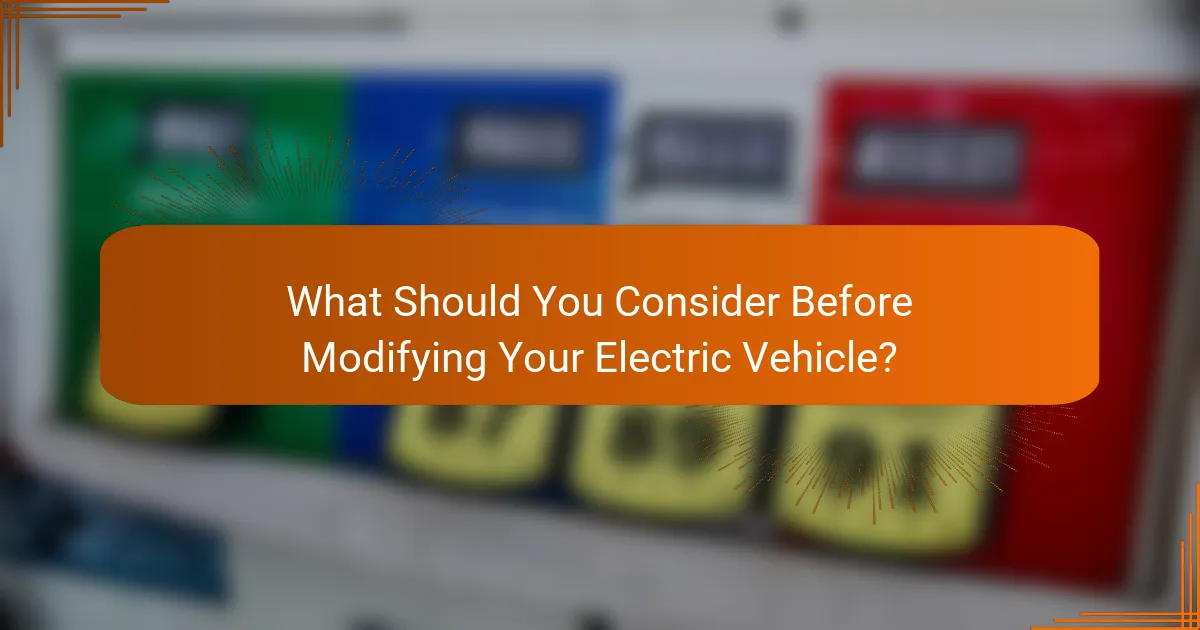Budget performance modifications for electric vehicles (EVs) offer a practical way to enhance efficiency and power without a hefty investment. By focusing on cost-effective options such as DIY upgrades and affordable aftermarket parts, drivers can significantly improve acceleration, handling, and overall driving experience while maintaining financial sensibility.

What Are the Best Budget Performance Mods for Electric Vehicles?
Budget performance mods for electric vehicles (EVs) focus on enhancing efficiency and power without significant investment. Key modifications can improve acceleration, handling, and overall driving experience while maintaining cost-effectiveness.
ECU Remapping
ECU remapping involves reprogramming the vehicle’s electronic control unit to optimize performance parameters. This modification can enhance throttle response and increase power output, often resulting in a more engaging driving experience.
When considering ECU remapping, ensure that the modifications comply with local regulations to avoid warranty issues. Look for reputable tuners who specialize in EVs to guarantee safe and effective changes.
Performance Tires
Upgrading to performance tires can significantly improve traction and handling, which is crucial for enhancing an EV’s performance. These tires are designed to provide better grip during acceleration and cornering, making them a worthwhile investment.
Consider tires that are specifically rated for electric vehicles, as they often have lower rolling resistance and are designed to handle the unique torque characteristics of EVs. Regularly check tire pressure to maintain optimal performance and longevity.
Lightweight Wheels
Replacing stock wheels with lightweight alternatives can reduce unsprung weight, improving acceleration and handling. Lighter wheels allow for quicker response times and can enhance overall vehicle dynamics.
When selecting lightweight wheels, ensure they are compatible with your EV’s specifications. Aluminum alloys are a popular choice due to their strength and weight advantages, but be mindful of potential increases in cost.
Upgraded Battery Management Systems
An upgraded battery management system (BMS) can optimize battery performance and longevity. A better BMS can enhance charging efficiency and thermal management, leading to improved range and battery health.
Look for BMS options that offer advanced features like real-time monitoring and customizable settings. Ensure that any upgrades are compatible with your EV’s existing systems to avoid complications.
Aftermarket Air Filters
Installing aftermarket air filters can improve airflow to the electric motor, potentially enhancing performance. These filters often provide better filtration and can be more efficient than stock options.
Choose high-quality filters that are designed for your specific EV model. Regular maintenance and replacement of air filters can also help maintain optimal performance over time.

How Do Performance Mods Impact EV Efficiency?
Performance modifications can significantly influence the efficiency of electric vehicles (EVs) by enhancing their speed, range, and overall weight. Understanding these impacts helps drivers make informed decisions about which mods to pursue for optimal performance without sacrificing efficiency.
Improved Acceleration
Performance mods such as upgraded motors or enhanced battery systems can lead to improved acceleration in EVs. These modifications often allow vehicles to achieve higher torque levels, resulting in quicker starts and faster speeds. For instance, a well-tuned electric motor can reduce acceleration times from 0 to 60 mph to under 4 seconds.
However, while faster acceleration can be thrilling, it may also lead to increased energy consumption. Drivers should consider the trade-off between performance gains and potential reductions in overall efficiency, especially during aggressive driving.
Enhanced Range
Modifications aimed at enhancing the range of an EV typically involve battery upgrades or improved aerodynamics. Larger capacity batteries can extend the driving distance between charges, making long trips more feasible. For example, upgrading to a battery with a capacity increase of 20-30% can provide an additional 50-100 miles of range.
It’s crucial to balance these modifications with the weight they add to the vehicle. Heavier batteries can offset range improvements, so selecting lightweight materials and designs is essential for maximizing efficiency.
Weight Reduction Benefits
Reducing the weight of an electric vehicle can significantly enhance its efficiency and performance. Lightweight materials, such as carbon fiber or aluminum, can decrease the overall mass, leading to less energy required for acceleration and improved range. A weight reduction of 10-15% can yield noticeable benefits in energy consumption.
When considering weight reduction, focus on components that provide the most significant impact, such as wheels, body panels, and battery housing. However, ensure that safety and structural integrity are not compromised in the pursuit of lighter materials.

What Are Cost-Effective Options for EV Performance Enhancements?
Cost-effective options for enhancing electric vehicle (EV) performance include DIY modifications, affordable aftermarket parts, and used performance components. These approaches can improve speed, handling, and overall driving experience without breaking the bank.
DIY Modifications
DIY modifications can be a great way to enhance your EV’s performance while saving money. Simple upgrades like improving aerodynamics with lightweight materials or adjusting tire pressure for better handling can yield noticeable improvements. Additionally, software tuning can optimize battery management and energy efficiency.
Before starting any DIY project, research the specific modifications that are compatible with your EV model. Ensure you have the necessary tools and skills, or consider joining online forums for guidance and support from fellow enthusiasts.
Affordable Aftermarket Parts
Aftermarket parts can provide significant performance boosts at a lower cost than OEM options. Look for reputable brands that offer components like upgraded batteries, high-efficiency motors, or performance tires. These parts often come with warranties and can be installed without professional help.
When selecting aftermarket parts, compare prices and read reviews to ensure quality. Consider local regulations regarding modifications, as some parts may not be street-legal in certain areas.
Used Performance Components
Purchasing used performance components can be a budget-friendly way to enhance your EV. Many enthusiasts sell parts after upgrading their vehicles, allowing you to find high-quality components at a fraction of the original price. Websites and local marketplaces often have listings for used batteries, motors, and other performance-enhancing parts.
When buying used components, inspect them thoroughly for wear and compatibility with your vehicle. Always verify the seller’s reputation and consider asking for a return policy in case the part does not meet your expectations.

Which Electric Vehicles Are Best for Performance Mods?
Electric vehicles (EVs) that are best for performance modifications typically offer a combination of powerful motors, robust battery systems, and a supportive aftermarket community. Popular models like the Tesla Model 3, Nissan Leaf, and Ford Mustang Mach-E provide various options for enhancing speed, handling, and overall driving experience.
Tesla Model 3
The Tesla Model 3 is a top choice for performance mods due to its advanced electric powertrain and extensive aftermarket support. Modifications can include software upgrades that enhance acceleration and handling, as well as hardware changes like improved suspension and brakes.
Common performance enhancements for the Model 3 include installing a performance boost software package, which can reduce 0-60 mph times significantly. Additionally, upgrading to performance tires can improve grip and handling, making the driving experience more exhilarating.
Nissan Leaf
The Nissan Leaf, while primarily known for its efficiency, can also be modified for better performance. Options include battery upgrades and lightweight components that can enhance acceleration and overall agility. However, the Leaf’s aftermarket is less extensive compared to other models.
For those looking to modify a Leaf, consider focusing on weight reduction strategies and improving aerodynamics. Simple changes like removing unnecessary interior components or adding a rear spoiler can yield noticeable improvements in performance.
Ford Mustang Mach-E
The Ford Mustang Mach-E combines the classic Mustang heritage with electric performance, making it a strong candidate for modifications. Its robust platform allows for various enhancements, including performance tuning and upgraded suspension systems.
Modifications for the Mach-E can include installing a performance chip that optimizes power delivery and throttle response. Additionally, upgrading the braking system can enhance safety and performance during spirited driving. As with any modifications, ensure that changes comply with local regulations to maintain vehicle legality.

What Should You Consider Before Modifying Your Electric Vehicle?
Before modifying your electric vehicle (EV), consider how changes may affect performance, warranty, and compliance with local laws. Understanding these factors can help you make informed decisions that enhance your driving experience without unintended consequences.
Warranty Implications
Modifications to your electric vehicle can void the manufacturer’s warranty, especially if they affect the vehicle’s electrical systems or battery. Always check your warranty terms before making any changes, as some manufacturers may allow specific upgrades while others may not.
For example, installing aftermarket performance parts or software can lead to warranty claims being denied. It’s advisable to consult with your dealer or manufacturer to clarify what modifications are permissible without risking your warranty coverage.
Local Regulations
Local regulations regarding vehicle modifications can vary significantly by region. Some areas may have strict rules about emissions, safety, and vehicle modifications, which could impact your ability to legally drive your modified EV on public roads.
Before proceeding with any modifications, research your local laws to ensure compliance. This may include checking with your local Department of Motor Vehicles (DMV) or equivalent authority to understand any necessary inspections or approvals required for modified vehicles.
